Clapperboard

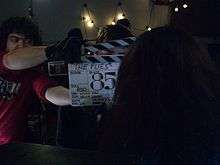
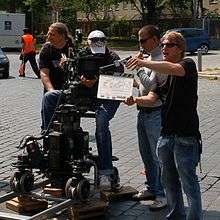
A clapperboard is a device used in filmmaking and video production to assist in synchronizing of picture and sound, and to designate and mark the various scenes and takes as they are filmed and audio-recorded. Other names include clapper, clapboard, clacker, slate, slate board, slapperboard, sync slate, time slate, sticks, board, smart slate, dumb slate[1] and sound marker.
When a movie's sound and picture are out of synchronization, this is known as lip flap.
Overview
Clapperboards have been essential to filmmaking since the earliest sound films because (until the advent of digital cinematography) visual and audio tracks were recorded on separate media by separate equipment. The clapperboard combines a 'chalkboard slate' with a 'clapstick'. The slate displays the name of the production, the scene and "take" about to be performed, and similar information;[2] an assistant holds the clapperboard so the slate is in view of the cameras, speaks out information for the benefit of the audio recording, then opens the clapstick and claps it shut. The shutting of the clapstick is easily identified on the visual track, and the sharp "clap" noise is easily identified on the separate audio track; the two tracks can later be precisely synchronised by matching the sound and movement. And since each take is identified on both the visual and audio tracks, segments of film are easily matched with segments of audio.
Traditional clapperboards consisted of a wooden slate with a hinged clapstick attached to its top. Modern clapperboards generally use a pair of wooden sticks atop either a whiteboard or a translucent acrylic glass slate (the latter being easily legible via the light coming through it from the scene about to be shot). Smart slates or digislates are electronic SMPTE time code versions with digitally displayed information. The clapsticks traditionally have diagonally interleaved lines of black and white to ensure a clear visual of the clap in most lighting conditions. In recent years sticks with calibrated color stripes have become available. In some productions, particularly those created in the digital domain, electronically superimposed versions of a clapperboard have supplanted the real thing.
The slate typically includes the date, the production title, the name of the director, the name of the director of photography (DP) and the scene information — which follows two popular systems:
- American: scene number, camera angle and take number; e.g. scene 24, C, take 3;
- European: slate number, take number (with the letter of the camera shooting the slate if using multiple-camera setup); e.g. slate 256, take 3C.
Often the European system will also include the scene number; however, a separate continuity sheet that maps the slate number to the scene number, camera angle and take number may be used if the scene number is not included on the slate. This is generally not as great a concern with short films, however. The clapper loader (or 2nd AC) is generally responsible for the maintenance and operation of the clapperboard, while the script supervisor is responsible for determining which system will be used and what numbers a given take should have. While these are usually fairly obvious once a system has been agreed upon, the script supervisor is usually considered the final arbiter in the event of an unclear situation.
A verbal identification of the numbers, known either as "voice slate" or "announcement", occurs after sound has reached speed. At the same time or shortly thereafter, the camera will start running, and the clapperboard is then filmed briefly at the start of the 'take' and the clapsticks are clapped sharply as soon as the camera has reached sync speed. Specific procedures vary depending on the nature of the production (documentary, television, feature, commercial, etc.) and the dominant camera assisting conventions of the region; therefore it is not possible to describe a definitive practice aside from the general principles.[3] Occasionally, instead of preparing an actual slate, a voice slate will be announced (often by an actor in the scene) and then the actor will clap their hands together, to provide the synchronisation mark.
Sometimes a tail slate or end slate is filmed at the end of a take, during which the clapperboard is held upside-down. This is done when the clapperboard was not captured at the start of the take due to the camera being set up for the shot in such a way that the board cannot be captured, for example when a specific focus or frame is set up and cannot be altered until the take is complete. A clapper board is generally used to identify all takes on a production, even takes that do not require synchronization, such as MOS takes. When a slate is used to mark an MOS take, the slate is held half open, with a hand blocking the sticks, or closed, with a hand over the sticks.
The clapper (two sticks hinged together) was invented by F. W. Thring (father of actor Frank Thring), who was head of Efftee Studios in Melbourne, Australia. Some mention that Efftee was not founded until 1931, not in the 1920s as sometimes stated.[4] However, the date of Efftee's founding does not assume the start of F.W. Thring's involvement in the industry. Consider the start of the Australian film industry with 1906's The Story of the Kelly Gang, which was the first feature length narrative film in the world. The director of this film, Charles Tait, was associated with J. C. Williamson. The former's production company, J. & N. Tait, merged with the J. C. Williamson Film Company. F.W. Thring was managing director of J.C. Williamson Films in 1918. The clapboard with both the sticks and slate together was refined by Leon M. Leon (1903–1998) a pioneer sound engineer.[5]
 A Denecke clapperboard containing LED display with SMPTE Timecode and colored stripes on the sticks.
A Denecke clapperboard containing LED display with SMPTE Timecode and colored stripes on the sticks.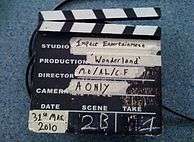 A traditional wooden slate clapperboard.
A traditional wooden slate clapperboard.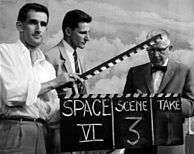 Clapperboard c. 1953
Clapperboard c. 1953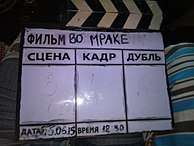
References
| Wikimedia Commons has media related to Clapperboards. |
| Look up clapperboard in Wiktionary, the free dictionary. |
- The Two Frank Thrings - Peter Fitzpatrick — Monash University Publishing, 2012
- ↑ npr.org
- ↑ Soniak, Matt. "Why Do They Click That Board Thing Before Filming A Movie Scene?". Mental Floss. Retrieved 2015-12-27.
- ↑ "Studio TV Production". Cybercollege.org. Retrieved 2012-06-18.
- ↑ Frank Thring (I) - Biography
- ↑ imdb.com